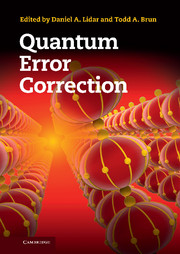Book contents
- Frontmatter
- Contents
- List of contributors
- Prologue
- Preface and guide to the reader
- Acknowledgements
- Part I Background
- Part II Generalized approaches to quantum error correction
- Part III Advanced quantum codes
- Part IV Advanced dynamical decoupling
- Part V Alternative quantum computation approaches
- 16 Holonomic quantum computation
- 17 Fault tolerance for holonomic quantum computation
- 18 Fault-tolerant measurement-based quantum computing
- Part VI Topological methods
- Part VII Applications and implementations
- Part VIII Critical evaluation of fault tolerance
- References
- Index
17 - Fault tolerance for holonomic quantum computation
from Part V - Alternative quantum computation approaches
Published online by Cambridge University Press: 05 September 2013
- Frontmatter
- Contents
- List of contributors
- Prologue
- Preface and guide to the reader
- Acknowledgements
- Part I Background
- Part II Generalized approaches to quantum error correction
- Part III Advanced quantum codes
- Part IV Advanced dynamical decoupling
- Part V Alternative quantum computation approaches
- 16 Holonomic quantum computation
- 17 Fault tolerance for holonomic quantum computation
- 18 Fault-tolerant measurement-based quantum computing
- Part VI Topological methods
- Part VII Applications and implementations
- Part VIII Critical evaluation of fault tolerance
- References
- Index
Summary
In Chapter 16 it was shown how holonomic quantum computation (HQC) can be combined with the method of decoherence-free subspaces (DFSs), leading to passive protection against certain types of correlated errors. However, this is not enough for fault tolerance since other types of errors can accumulate detrimentally unless corrected. Scalability of HQC therefore requires going beyond that scheme, e.g., by combining the holonomic approach with active error correction. One way of combining HQC with active quantum error-correcting codes, which is similar to the way HQC is combined with DFSs, was also mentioned in Chapter 16. This approach, however, is not scalable since it requires Hamiltonians that commute with the stabilizer elements, and when the code increases in size, this necessitates couplings that become increasingly nonlocal.
In this chapter, we will show how HQC can be made fault tolerant by combining it with the techniques for fault-tolerant quantum error correction (FTQEC) on stabilizer codes using Hamiltonians of finite locality. The fact that the holonomic method can be mapped directly to the circuit model allows us to construct procedures that resort almost entirely to these techniques. We will discuss an approach that makes use of the encoding already present in a stabilizer code and does not require additional qubits [O08, OBL08]. An alternative approach, which requires ancillary qubits for implementing transversal operations between qubits in the code, can be found in [O09].
- Type
- Chapter
- Information
- Quantum Error Correction , pp. 412 - 431Publisher: Cambridge University PressPrint publication year: 2013



